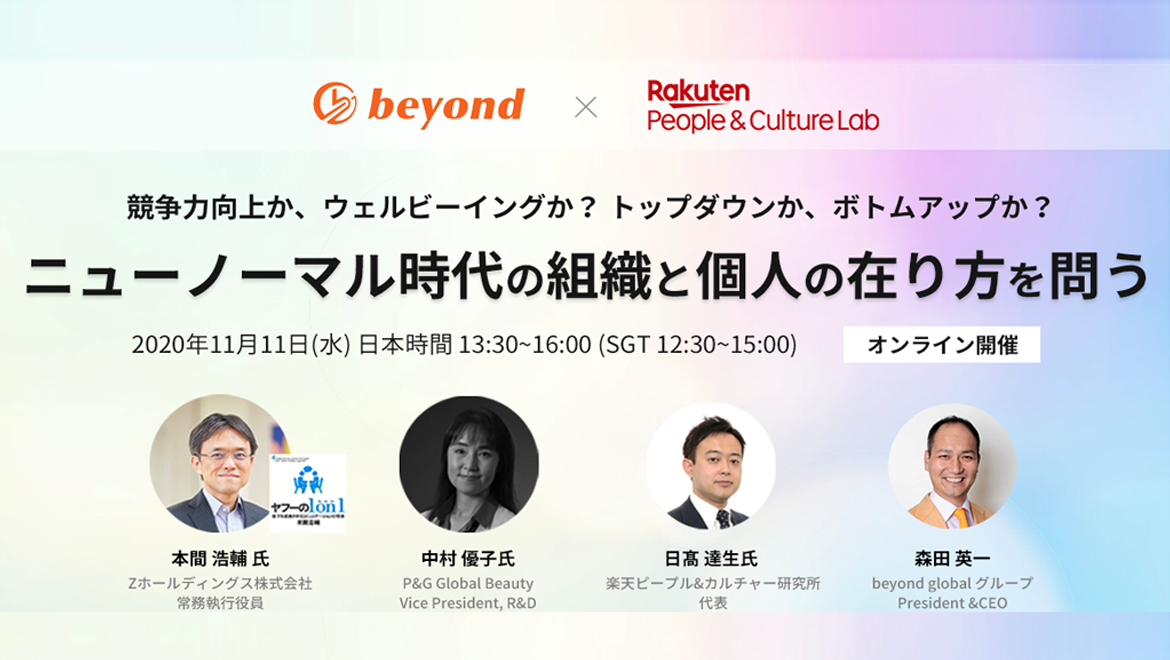This is the second part of a two-part review of the interesting discussion that took place at “Questioning what’s best for individuals and organizations in the New Normal era,” a joint webinar that was held with beyond global in November 2020.
You can find an overview of the webinar (in Japanese) here.
Panelists: Kosuke Homma (Z Holdings Corporation), Yuko Nakamura (Procter & Gamble), Eiichi Morita (beyond global group), Tatsuo Hidaka (Rakuten People & Culture Lab)
Well-being and competitive strength
We will answer the question “Is it possible to compete with fast-growing companies while promoting well-being?” The key is a corporate strategy that is appropriate for your company’s growth stage and the market environment, along with a consistent human resources strategy. What is important is identifying the situation concerning your company without getting distracted by various particulars or policy theories.
―Mr. Morita: Can Japanese companies promote well-being and still win against Chinese companies that work with fierce momentum like Alibaba?
Mr.Honma: You have to determine what the source of your competitive advantage is and what it is your aiming for. For GAFA and similar companies, they’re battling in a “winner takes all” world and assign their finest talent to the task. For example, if there’s something to be gained by working without sleep, then it’s fine for them to do that. But you have to be very careful when it comes to thinking that just because other companies aren’t working due to work-style reforms that your company won’t work either, or that your company will work because other companies are working hard. What is a company’s competitive strength? The particulars and method theories come after a strategy, vision and battle approach are in place.
Ms. Nakamura: Gathering people of a certain generation who are eager to work like crazy and constantly recruiting similar talent while letting those who don’t want to work that way quit is, I think, one possible strategy for a company. Diversity is our company’s strategy. We seek sustainable productivity by requiring a combination of freedom and high performance with our diverse, emotionally and physically healthy colleagues from around the world. And all of our systems are consistent with this strategy.
One memorable essential point that was made is that the logic of a company’s corporate philosophy, business strategy, and human resources strategy is important as the logic for promoting well-being. It isn’t a relative matter of good or bad but, rather, requires that you ask what the most appropriate approach to well-being is for your company
Involving top management and individual independence
When it comes to the promotion of well-being, one essential discussion concerns the involvement of top management and individual independence.
―Mr. Morita: Should (well-being) be promoted through a top-down or bottom-up approach?
Mr. Homma: The job of top management is to decide whether or not to do something. They should determine the order of priority. In particular, the following three points are important in the promotion of well-being in Japanese companies.
The assumption is that highly convincing evaluations can be made.
2.Workers will choose companies that don’t just seek monetary benefits, but also contribute to the world and value their employees. The need must not be for profit, but rather to acquire the best talent.
3.The companies most likely to be chosen are those that offer compelling compensation, good colleagues, and opportunities to do good work.
―Mr. Morita: As for the autonomy of personnel, how should employees with low levels of autonomy be handled?
Ms. Nakamura: First of all, you should conduct screenings when recruiting. We provide support through a performance-improvement plan and, should an employee’s performance not improve in accordance with our value standards, we will recommend an occupational change to another company for a position better suited to that individual’s abilities. At our company, since employees are entrusted with independence, we need to ensure that there are no people with low self-management abilities in any position. Even if we have someone who quits, based on their experience at our company, most of them are able to find a better position and work their way up the career ladder.
―Mr. Morita: What are the key points in involving and persuading management?
Mr. Homma: Rather than expecting too much from top management, I think it would be more persuasive to get things moving from the front lines. As for me, when I worked in HR, I implemented around 50 to 60 measures. A lot of them failed, of course. I think it’s best to initiate change from your own organization in accordance with your company’s needs at the time.
While there are no absolute correct answers that can be applied to each company, many of the participants supported the point that it is important to start with your immediate surroundings, initiating change within a radius of a few meters based on your company’s business and HR strategies.

